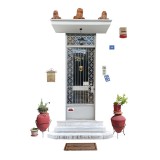This research explores the concept of threshold in architecture. The nature of the threshold as a field seems to be closely related to concepts such as that of the boundary /border as well as the term of in-between space. With the identity of the threshold not being identified with either of the qualities of the spaces around it, but instead with itself operating as a mediator between them, the threshold seems to adopt the role of a prolonged and inhabitable boundary, charged with a series of everyday practices. With its dual nature and its function as a 'switch' between heterogeneous conditions, the key question arises of how it becomes a facilitator of this two-way relationship as well as what are the characteristics that manifest this status. In order to investigate this question, the research focuses more on, as Herman Hertzberger characterizes it, the 'ultimate threshold', the entrance to the house. With the aim of understanding and perceiving its value, both the threshold and its passage are subject to a process of deconstruction. Though this process emerges the equipment and special characteristics that serve the function of the threshold and which in this research are defined as its "object vocabulary".Furthermore, the recognition of the threshold as the city's diode to the privacy of the residence, raises a new series of questions about this two-way boundary relationship. The question this time, shifts to the interaction between the inside and the outside or otherwise between the domestic and the urban. In this context, the research implements a spatial interpretation of various thresholds encountered in the city, in order to explore this crucial point of simultaneous union and intersection.
